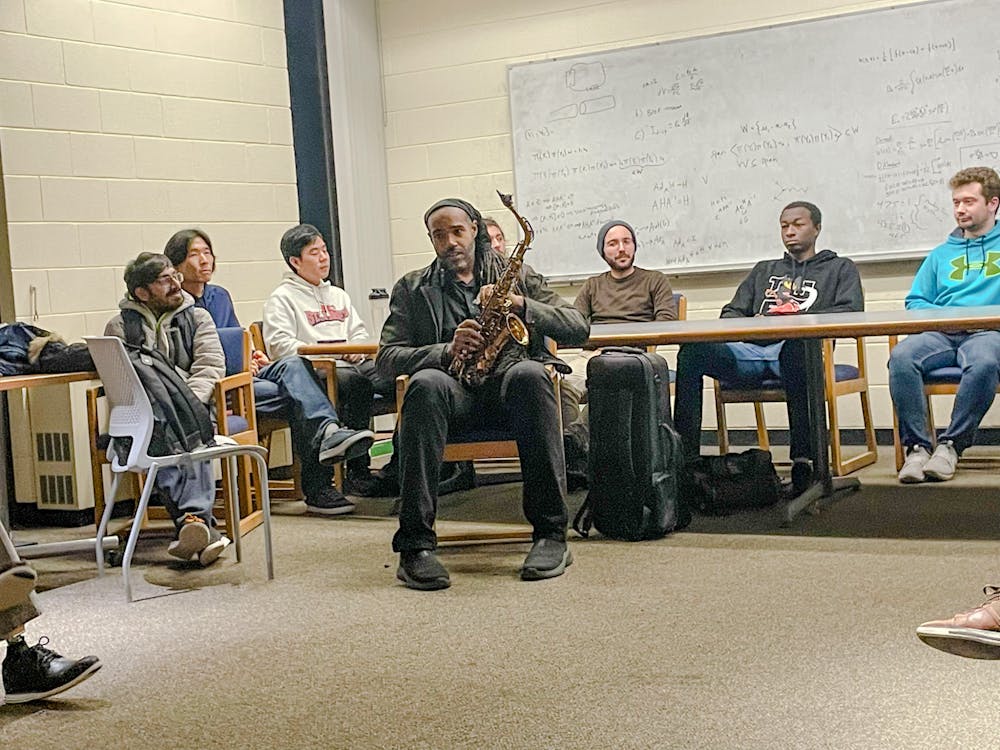In an improvisation workshop Wednesday, jazz saxophonist and mathematician Marcus Miller engaged University students in a live saxophone performance and discussed the connections between physics, math and music.
Based in New York City, Miller turned to music after earning a mathematics degree at Harvard. According to Miller’s website, he has performed at Madison Square Garden, the “Late Show with Stephen Colbert,” Carnegie Hall and the White House. Throughout his career, Miller has played alongside artists such as The Fugees and Madonna.
Miller opened Wednesday’s event by playing an improvised saxophone piece before pivoting to a discussion on the intersections between music and physics.
For Miller, the way physics researchers build on past knowledge is similarly “performative” to musical improvisation. “There’s a very popular misconception that improvisation (with music) is making everything up as you go,” he said. But “there’s a lot of ground knowledge needed to improvise.”
Miller also spoke about the pursuit of knowledge more generally. He encouraged attendees to explore questions that may not necessarily lead to answers but instead ones that develop “some kind of foothold in your mind.”
Revsen Karaalp ’23, one of the event’s attendees, said that Miller’s workshop inspired her to consider new ways of thinking about her physics coursework.
“It gave me some inspiration on how to deal with (my) coursework when I’m struggling,” Karaalp said. “I was inspired by the freedom (Miller) said you get when mastering the material — so much that you just need a pen and paper or board and can just go with it.”
The improvisation workshop is the first in a series hosted under Miller’s role as the inaugural artist-in-residence with the Department of Physics, which was created as part of the University’s Academic Departmental Diversity and Inclusion Action Plans. Professor of Physics Stephon Alexander PhD’00 said the department plans to host a dancer as next semester’s artist-in-residence.
“We’re building the program together,” Miller said, citing his collaboration with the physics department in developing “the shape of the (residency’s) experience.”
Alexander added that the DDIAP is pushing his department to engage with outside disciplines.
“We wanted to celebrate diversity in its fullest form … as well as intellectual diversity, and sort of bring that into our department, exploring the artistic and creative side of physics,” Alexander said. “People need to realize that there is art in the sciences and science in the arts, and that science departments can also be a meeting place for these types of … engagements.”
According to Miller, Alexander contacted him about possibly joining the artist-in-residence program in October. He remembers being excited about collaborating with experts in a field far removed from his work as a musician.
“If I were to pursue sciences full-time, I would have … to quit music,” Miller said. “What it came down to (when) dealing with these two competing demands on my soul was really thinking about what it is in each topic that (gives) me joy and … a sense of wonder and life.”
“There’s something deeply related to beauty in the way the ideas are built in both fields, and if I can find some access to that and share it with others, I consider that something worthwhile to do in life,” he added.
Alexander said that Miller has been a welcomed addition to the physics department. Miller is “a very engaging and nice person,” which has allowed students to respond to the artist-in-residence program “with a lot of enthusiasm,” he said.
“I would say that everybody I’ve met has been extraordinarily … friendly and welcoming,” Miller said. The department “has put up with my childlike and perhaps obnoxious curiosity with great poise.”





